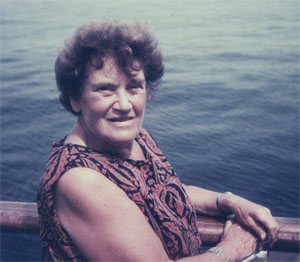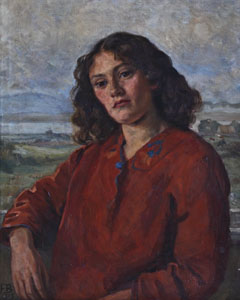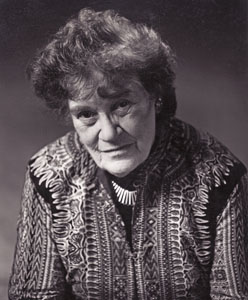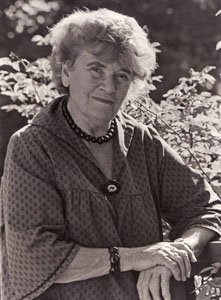Lettice Ramsey - Obituaries and
feature article
Lettice Ramsey was my maternal
grandmother, and a great character. Without her
encouragement from about the age of ten or even younger,
it is doubtful that I would have developed my keen
interests in either wildlife or photography. Here are a
couple of her obituaries, with a few additions/corrections
in square brackets.
From
The Times, 30 July, 1985
With the death of Lettice
Ramsey on July 12th [1985], Cambridge has lost a
notable character. Born on August 2, 1898, the
daughter of English parents, she spent her early
years under a governess in County Sligo [Ireland]
where her father [Cecil Baker] had an oyster farm
and her talented mother [Frances Baker] (trained
at the Slade) painted.
She was then sent to Bedales
and from there went up to Newnham [Cambridge
University] to read philosophy. In 1925 she
married the brilliant mathematician and
philosopher, Frank Ramsey,
and they had two daughters [Jane and Sarah]
before Frank tragically died in 1930 at the age
of only 26 [from liver disease].
Lettice then decided on
photography for a living, took a course at Regent
Street Polytechnic ("one term was quite
enough") and joined forces with Helen
Muspratt: "She had the know-how, I had the
connections."
Connections, indeed. Lettice
had, or made, and a long succession of unposed,
lively portraits of the intellectual and literary
luminaries of the pre-war flowed from the
Cambridge studio - Vanessa Bell, Virginia Woolf,
Kathleen Raine, Victor Rothschild, J. D. Bernal,
Dorothy Hodgkin, C. P. Snow, Joan Robinson and
many more [including the notorious Guy Burgess,
Donald Maclean and Anthony Blunt in the 1930's].
In 1937 Helen Muspratt moved
to Oxford, while Lettice remained active in
Cambridge - activity which included climbing the
scaffolding in King's Chapel in her seventies to
photograph the [stained glass], and being locked
in for her pains.
[It was not until her 80'th
birthday that Lettice finally retired from being
a professional photographer].
Photography was only one of
Lettice's pursuits. She made pottery and collages;
she was a persistent and adventurous traveller;
and she had that rare quality of making her
recurrent parties a success by enjoying them so
much herself. [She was also interested in natural
history, and often recalled being kept awake at
night as a child on the west coast of Ireland by
the rasping call of Corncrakes - presumably
abundant in those days.]
Having suffered the tragedy
of Frank’s death, and the later death of her
younger daughter [Sarah], it was as though she
challenged life to repay the debt it owed her:
and she saw to it that life paid up, right to the
end.
[Lettice was survived by her
elder daughter Jane, and grandchildren Stephen,
Belinda and Matthew Burch].
|
And a slightly less formal
one:
From
the Cambridge Evening News, July 18th, 1985.
When Lettice Ramsey tried to
get into Cambodia she was stopped because she
carried a camera and the authorities thought she
was a journalist. She immediately arranged for
herself another passport describing her
occupation as "housewife". She got into
Cambodia and took some excellent photographs
there. excellent photographs
there.
This incident was typical of
Lettice Ramsey's approach to life. It was her
originality, quick thinking and undoubted
artistic flair which established her as one of
Cambridge's leading photographers and which kept
her at the forefront for decades.
She was born in Ireland in
1898 and was educated in this country at Bedales
School and Newnham College, Cambridge. At
Cambridge she read moral sciences and in her
early 20s married Frank Ramsey,
the brilliant King’s philosopher, who
tragically died five years later.
She was left with two young
daughters and very little training to equip her
for a commercial career. She studied briefly at
the Regent Street Polytechnic in London and then
set up in business as a photographer.
She was instantly successful
and rapidly became fashionable, photographing the
influential and the up and coming throughout the
30s. Anthony Blunt, later to gain a knighthood
only to be stripped of it for spying was among
the sitters. Another was Virginia Woolf.
Lettice Ramsey took into
partnership another gifted woman photographer.
Helen Muspratt, whose name remained with the
business until Lettice retired in 1978. Lettice
Ramsey lived her entire career in Cambridge at
Mortimer Road.
|
There is
also this article which appeared in the Times well before
her death in about 1969 which gives some further insight
into her remarkable life and strength of character. I
have added the text in square brackets to clarify/extend/correct
some of the contents.
Cambridge’s own first
lady
By Sara Payne, The Times, c.1969
Mrs. Lettice Ramsey, sister-in-law
of the [then] Archbishop of Canterbury [Michael
Ramsey], was refused an entry visa into Cambodia
earlier this year. A professional photographer
with her own business in Cambridge Mrs. Ramsey,
who is 71, had to acquire a new passport
describing herself as a housewife before she was
persona grata.

She found it "rather infra dig" to
pretend that she had recently retired from
photographing a few weddings—she runs in
fact a highly professional business — in
order to convince the authorities that she was
not a snooping journalist. Neither a journalist,
nor a housewife, and far from retirement—"I
shall never retire, I shall just ease out"—Mrs.
Ramsey, a widow, who is without doubt Cambridge's
own first lady, has just been round the world for
the second time.
Friend of Virginia Woolf, Julian Bell and the
philosopher Wittgenstein. she went with her
sister in a spirit of adventure characteristic of
the indefatigable women of the Edwardian
generation — the age in which she grew up on
her parent's oyster bed in the west of Ireland. [Not
strictly true! - her father who died when Lettice
was only about 5 - briefly farmed an oyster bed].
Her imagination fired by a friend's description
of Cambodia, she visited the country in the last
days of Prince Sihanouk's regime. Her week's stay
in Phnom Penh and Siem Reap was unmarred by
military manoeuvres. She and her sister, in the
dark about impending political ructions, jogged
round in a tiny trishaw from temple to temple. (Mrs.
Ramsey recalls that they had difficulty in
fitting their two bottoms side by side on the
little seat, so took it in turns to perch on an
extra bench above.)
One can imagine her travelling in the spirit of
Aunt Dot in Rose Macaulay's The-Towers of
Trebizond, as she said to her niece. "Take
my camel, dear as she climbed down from this
animal on her return from High Mass".
Mrs. Ramsey is sad that such pleasant people as
the Cambodians have been drawn into the Indo-China
war. As she rightly points out the war will have
a very adverse effect on the tourist trade, upon
which the country relies so much.
When asked if in spite of the tightening up of
security she managed to take any photographs, she
replied indignantly, "I took hundreds
". Mrs. Ramsey, who has been a professional
photographer since 1932, also took hundreds in
Nepal, Australia, New Zealand, Fiji and Mexico
during her three and a half month second odyssey
round the world. She is a fund of anecdotes. In
particular the national dress of Fiji—the
tunic/sarong combination—took her fancy.
"When you want to do anything you take off
the bottom half and you have a nice little mini."
Mrs. Ramsey may be a seasoned traveller—she
first went round the world in 1948, and earlier,
in 1933, went on a good-will trip to Stalin's
Russia —but she has put her roots firmly
down in one place—Cambridge.
She first went there as an undergraduate from
Bedales School just after the First World War to
read moral sciences at Newnham. A contemporary of
Lady Bragg, Mrs. Ramsey spent most of her time
trying to get the strict rules of the college
relaxed."You weren't allowed to go to the
theatre or visit a tea room without a chaperone."
She used the hole in the fence of the dons'
garden to return from nightly sorties "By
the time I left in 1929 you were able to
entertain men in your room provided another
student was there." She and her friends now
have a "good deal of giggles " over the
present generation's attitude towards sex. "They
behave as if they discovered it".

But Mrs. Ramsey, who was [briefly] married to
Frank Ramsey, the highly gifted mathematician and
fellow of King's College, remembers that there
was a certain decorum attached to punting.
Nowadays people can swirl helplessly round on the
river without any sort of expertise, making fools
of themselves and annoying others. Punting
novitiates were only allowed out before breakfast
in her day, even though many of them went to May
balls in tweeds.
And then there was all the dancing. "Every-one
was dancing mad after the First World War. They
thought here is peace, everything is going to be
wonderful. My time at Newnham was spent dancing."
She remembers the euphoria of Armistice Day."I
went round on the top of a bus ringing a bell."
During a life time spent in Cambridge at the
centre of intellectual and artistic life, Lettice
Ramsey who in a moment of confidence "told
all" to Virginia Woolf, has known many of
the jeunesse doree of the century. She was a
friend of Vanessa Bell's son Julian who was
killed tragically in the Spanish Civil War.
"This was the one cause people felt they
could do something about."
Maynard Keynes, the economist was "very,
clever at putting the ordinary kind of person at
their ease. He made you feel more intelligent
rather than less." She helped Wittgenstein
whose Tractatus Logicus was translated into
English by Frank Ramsey, look for digs in
Cambridge. "But he was a difficult character
who made everything into a controversial moral
problem. He turned down the rooms they found
because he felt the family should not be letting
rooms while living in the basement."
The pleasure loving Guy Burgess of Burgess and
Maclean notoriety caused a stir among old
Cambridge friends when they heard of his
defection. "He did not seem a person who
would have carried his beliefs to that length,"
says Mrs Ramsey. "All intellectuals in
Cambridge were communists at that time. We had
great hopes, but then we were gradually let down."
Mrs Ramsey is not a woman who lives in the past
although her husband died at the age of 26. Still
very much at the centre of things she runs a
large house in Mortimer Road, near the Parker's
Piece cricket ground. It has been her home for 40
years. There she entertains her friends to cordon
bleu cooking and keeps the young—her
graduate lodgers—on their toes with her
energy and keen perception.
|
Lettice's
photographs
Some of Lettice's photographs still survive in the Ramsey
& Muspratt section of the Cambridgeshire
collection.
I am also gathering a
selection here.
Lettice's early
years
Here is some additional information on Lettice's early
years, which are only briefly touched upon in the above
material. Lettice was the daughter of Frances (nee Davis
Colley) and Cecil Baker. Frances was a very talented
amateur painter (trained at the Slade) and spent much of
Lettice's childhood painting, which left Lettice and her
younger sister (also called Frances) rather on their own.
For an example of her work, see the portrait of Lettice
above.
Lettice was from an
English family who for reasons that are not clear moved
to the west coast of Ireland, where Lettice was born in
1898 and brought up. This was at Rosses' Point, Co Sligo
– just a few miles north west of the town of Sligo.
Cecil Baker was an oyster farmer, until his early death
in about 1903, when Lettice was only about 4. This was
the first of three tragedies involving early deaths of
Lettice's close relatives. Her husband Frank died in 1930,
when Lettice was only 31 or 32. Lettice's younger
daughter Sarah died while still at University in 1949.
In 1904, after
Cecil’s death, the family moved from Rosses’
Point to somewhere which seems to have been called
Coillte-Laine, Co Sligo which was about 10 miles south
west of Sligo, to be near a friendly family. In England,
the family had connections with the Sussex area. A large
house called “Borough” or similar was involved.
They spent some of the year there.
I remember Lettice
saying that in her early days expeditions were limited by
the range of the available horse & cart – about
5 miles! She also spoke of hearing Corncrakes at night.
Lettice was sent to Bedales boarding school in England
when she reached secondary school. Her early days in
Ireland clearly meant a great deal to Lettice, and she
always enjoyed returning to the west coast of Ireland in
later years. We had a number of family holidays there in
the 1960's, the first of which in 1963 marked the start
of my interest in birding, and the start of my life list!
|